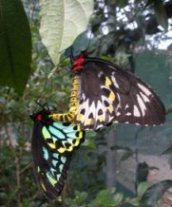Ways you can help
There are a number of ways you and your friends and family can help by understanding and raising awareness of the plight of our threatened species. Actions that contribute to conserving our biodiversity and sustainably using resources all ultimately help prevent extinction.
Protect threatened species at home

Attract wildlife to your garden:
- Plant native species in your garden to encourage local wildlife.
- Make your garden as natural as possible with ponds and vegetation layers from ground covers to trees.
- Avoid the use of pesticides as they can harm the insects that attract other native animals into your garden.
- Retain or revegetate natural bushland, especially along creeks and fence lines, so that animals can use them to move between bushland remnants.
- Establish nesting boxes for possums and birds in trees on your property.
Be a responsible pet owner:
- Register your dog or cat.
- Your dog should be ‘denned’ at night (where the dog is confined to its sleeping area).
- Try to restrict your cat’s time outdoors.
- Be ‘koala friendly’ by checking to see if there are koalas on your property and keeping your dog and koalas apart.
- Train your dog not to chase other animals.
- Keep your dog on its lead when walking on the beach so it does not chase shorebirds.
Help reduce pollution and waste in your neighbourhood:
- Recycle glass, paper and other household containers.
- Compost your organic wastes or investigate if your local council can provide a green bin.
- Minimise plastic usage by shopping with re-useable bags.
- Do not let polluted water or plastics into your storm-water drains, which flow into local rivers. Plastics can be carried by rivers out to sea and become a threat to marine life.
Help to conserve water in your garden:
- Choose water wise plants for the Queensland climate to save water and time spent caring for them.
- Leave fallen leaves and twigs on the ground, as this litter provides living places for many insects, increases nutrients in the soil, and reduces water loss.
- Install a rain-water tank.
Volunteer
There are various ways you can volunteer to help conserve threatened species and their habitat.
The Queensland Government has a list of potential volunteer projects you can get involved with.
There are many other small and large conservation organisations that offer volunteer opportunities across the state. Why not try contacting your local council or local naturalist groups to see what they have available.
Report sick or injured animals
Report any sick or injured wildlife (except crocodiles, cassowaries and marine strandings) to 1300 ANIMAL (1300 264 625).
Don’t risk injury. Keep safe and follow the guidelines for handling and transporting sick, injured and orphaned wildlife.
Koalas
If you find a sick, injured or dead koala call 1300 ANIMAL (1300 264 625).
Moggill Koala Rehabilitation Centre, cared for sick, injured and orphaned koalas, which are and then released back to the wild.
Cassowaries
Report cassowary sightings and incidents to the department on 1300 130 372, including sick and injured birds.
The Queensland Government is committed to caring for sick or injured cassowaries by maintaining an on-call response team and rehabilitating birds at a specialised cassowary rehabilitation centre at Garners Beach.
Crocodiles and marine strandings
Report sick or injured crocodiles, as well as turtles, dugongs and whales to the department on 1300 130 372.
Donate to a threatened species project
The Queensland Government plays a leading role—along with our partners and the community—in managing, protecting and restoring Queensland’s natural environment.
You can also play a role in supporting our work by making a donation to support some of our most important environmental initiatives.
Your donation will help support the protection of our state’s globally significant species and unique biodiversity through the protection, recovery and science and research-based initiatives to save our listed threatened fauna and flora species.
Find out more about donation options.